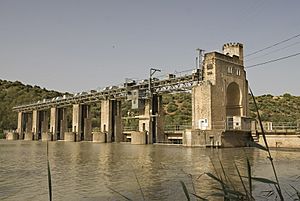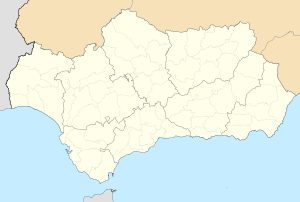El Salto Dam facts for kids
Quick facts for kids El Salto Dam |
|
|---|---|

El Salto Dam on the Guadalquivir River.
|
|
|
Location of El Salto Dam in the autonomous community of Andalusia.
|
|
| Official name | Presa El Salto |
| Country | Spain |
| Location | El Carpio, Province of Córdoba |
| Coordinates | 37°58′29″N 4°29′32″W / 37.97472°N 4.49222°W |
| Purpose | Power, irrigation |
| Status | Operational |
| Construction began | 1918 |
| Opening date | 1922 |
| Owner(s) | Endesa |
| Dam and spillways | |
| Type of dam | Barrage |
| Impounds | Guadalquivir |
| Height (foundation) | 20.7 m (68 ft) |
| Length | 253 m (830 ft) |
| Elevation at crest | 140 m (460 ft) |
| Reservoir | |
| Creates | El Carpio Reservoir |
| Total capacity | 18,000,000 m3 (15,000 acre⋅ft) |
| Normal elevation | 137.25 m (450.3 ft) |
| Power station | |
| Name | El Carpio Power Station |
| Coordinates | 37°57′56″N 4°30′0″W / 37.96556°N 4.50000°W |
| Commission date | 1922 |
| Type | Run-of-the-river |
| Hydraulic head | 19.74 m (64.8 ft) |
| Turbines | 3 Francis turbines |
| Installed capacity | 8.4 MW |
The El Salto Dam (also called Presa El Salto in Spanish) is a big structure on the Guadalquivir River in El Carpio, Spain. It includes both a dam and a hydroelectric power station. This means it helps control the river and makes electricity.
The dam is located near the road CO-412. Its special design, called Neo-Mudéjar, was created by architect Casto Fernández Shaw and engineers Carlos Mendoza and Antonio del Águila. A company named Mengemor built the dam between 1918 and 1922.
Since it was built, the dam has been very important. It has helped the local area grow and become stronger economically.
Contents
What is the El Salto Dam?
The El Salto Dam was built where old water mills used to be. It changes the riverbed's slope using two strong supports, one on each side of the river. There are also five supports inside the river.
These inside supports hold up a bridge and six sluice gates. Sluice gates are like big doors that control water flow. The supports also hold the machines that open and close these gates.
Dam's Unique Design
The support on the right side of the river forms an arched entrance over the road. It also has stairs leading to the control room. This room once had a cool octagonal (eight-sided) tower with a dome on top.
Many parts of the dam, like the horseshoe arches, special windows, and handrail supports, show the Neo-Mudéjar style. This style mixes old Spanish and Islamic art.
The entire dam is made of concrete. It is covered with blocks that look like traditional masonry (stone work).
How the Gates Work
Above the dam, there is a metal structure. It used to have a wooden platform, but now it has a metal grate. This structure holds the motors that power the gears and chains. These parts are used to lift the sluice gates.
A special bridge crane sticks out from the upstream side of the dam. From its two-story wooden cabin, an operator can place metal beams into slots. These beams help hold back the water, allowing the sluice gates to be worked on safely. The crane also lifts the motor and gear parts.
The dam is not just well-built with clever machines. It also has great artistic value and is still in good condition today.
El Carpio Hydroelectric Power Station
The El Carpio Power Station is located across the river from the dam. It was also built in 1922. This plant uses three turbine generators to make electricity. It is owned by Endesa, which is a very large power company in Spain.
How the Power Station Works
This power plant is a "run-of-the-river" type. This means it uses the natural flow of the river's water. It doesn't store much water in a big reservoir. So, how much electricity it makes depends on how much water is flowing in the river.
Water travels from the dam through a 1 kilometer (about 0.6 miles) long tunnel. It then goes into a small tank next to the power station. From this tank, the water flows through the turbines. After passing through the turbines, the water goes back into the river.
The moving water's energy spins the Francis turbines. Each turbine uses about 19 cubic meters (about 670 cubic feet) of water per second. This spinning creates mechanical energy. The generators then turn this mechanical energy into alternating current electricity.
The electricity needs to match the 50 Hz frequency used by Spain's power grid. To do this, the turbines and generators must spin at 214 rpm (rotations per minute). Finally, the plant's transformers increase the electric tension (voltage). This helps reduce energy loss when the electricity travels along power lines.
Power Station's Artistic Look
Just like the dam, the power station was built to look good. Its outside walls are made of cut stone blocks. The turrets (small towers) on its roof have brick domes. These features give the building a unique and artistic look.
One special detail is an elephant head supporting a balcony. This was made by the sculptor Juan Cristóbal González. The building even won a gold medal at an art exhibition in Paris in 1921!
See also
 In Spanish: Presa El Salto para niños
In Spanish: Presa El Salto para niños


